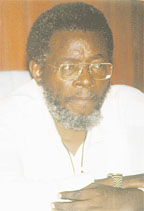-Luncheon tells parliamentary committee
Chairman of the National Insurance Scheme (NIS) Board, Dr Roger Luncheon has vowed that the institution will not fade away, even as it continues to he hard-hit by poor compliance which has resulted in questions about its ability to sustain itself.

The 40-year-old institution has come in for much criticism, and while he acknowledges that more work needs to be done in many areas, Luncheon yesterday told the parliamentary Sectoral Committee on Economic Services that the scheme has been burdened with matters which were not attended to in the past.
“We are working to correct this … But this is a big legacy problem,” he conceded.
All the members of the scheme’s board were present at the committee meeting but only three members of the Committee was present. A list of questions had been compiled for the body to respond to via a presentation to the Committee. However, only People’s Progressive Party/Civic (PPP/Civic) members of parliament: Gail Teixeira, Kwame Gilbert and Mohammed Khan were present. It was announced that PNCR-1G member Winston Murray had asked to be excused. Teixeira, who chaired the meeting, explained that since an interactive forum was necessary she requested a preview of the discussion and the substantial presentation will follow when a full complement of MPs is present.

Stabroek News was told that in the wake of the troubles plaguing Clico, the Committee had invited the NIS to a meeting that was scheduled for just before the annual parliamentary recess. However, it never came off. A week ago, members of the committee received a copy of a letter sent by Teixeira, to the NIS Board, inviting them to a meeting fixed for yesterday. The committee as a whole usually determines the schedule of meetings and, as a result, members who were not consulted on yesterday’s date had fixed other engagements.
In a brief overview, acting General Manager of the NIS Doreen Nelson provided some background information about the organization and touched on the various improvements that have been made in terms of the services offered over the years including the rate of reimbursements, extended medical care, the maternity grant and the yearly statutory increase in funeral benefits.
She further stated that the body has also sought to improve record keeping along with the recent introduction of the electronic submission of payment schedules. She revealed too that a conversion project is ongoing to change over the temporary numbering system which had led to some amount of inaccuracies.
She acknowledged that the scheme has had problems in processing benefits since the network was affected due to problems which the main generator developed.
Low compliance
The scheme is dealing with the issue of low compliance in terms of contributions but has not altered its list of benefits or rate of reimbursement. However, in this regard, she revealed that the body is seeking to create partnerships to assist it in dealing with this problem.
It is in this regard that Khan related his concerns about the increase in benefits without a corresponding increase in contributions.
“How will you maintain the system and pay benefits, he queried, and questioned too whether enough was being done by inspectors to bring persons into compliance with the law. He urged too that there probably needed to be a heightened awareness campaign to make persons aware of the importance of the scheme.
Khan also asked about the inaccuracies which persons complain of from time to time with regard to the spelling of their names thus affecting the efficient processing of claims.
Gilbert pointed to the 291,762 insured persons which he felt was not an accurate representation of the workforce insisting that, “we are missing some people.”
Responding to the concerns, Luncheon emphasized that the scheme was making efforts to correct many of the legacy issues which still face it.
In terms of the viability of the scheme Luncheon was adamant that “the scheme cannot fade”.
He said that while he understood that some of the criticisms levelled against it were genuine, many persons had vested interests in the scheme and would ensure that “it lives up to its mandate.”
He stressed that financial viability is always a concern of the board and noted too that more focus would have to be put on the management of expenditure and compliance in so far as revenue collected is concerned.
During questioning too the issue of targeting the self-employed and many others particularly those in the agricultural sector was raised and to this Luncheon pointed out that there may be a deficiency in the relevant legislation forcing some level of tentativeness as to how the scheme should go after the self-employed.
He explained that the scheme’s legislation goes into detail and addresses how to deal with the “employed” population. To this end, he posited that the self-employed category carried with it an expenditure that is not a reflection of the contributions it makes to the scheme. Against this background he stated that the self-employed should not be receiving better returns than an employed person, saying that it was a challenge to apply the legislation in dealing with the self-employed who in most cases make only yearly contributions.
As such Luncheon stated that for the scheme to go behind the self- employed could be to the financial disadvantage of the company.
With regards to dealing with defaulters, Luncheon admitted that the scheme could do much more to control the 7.1% shortfall in the rate of contributions. However he proposed that equally important was for those who are affected by defaulting employers to collaborate with the scheme, creating a coercive environment to ensure that employers subscribe to the law.
In his April 29, 2009 Sunday Stabroek business column, Christopher Ram noted that NIS income over the period 2004 to 2007 has increased by 24.6% while expenditure has increased by 38.4%. Expressed another way, he said expenditure as a percentage of income has moved within the short period of three years from 80.7% to 89.5%. Ram said the significance and danger of the increase is best seen when compared with the average of the five years 1997 to 2001 when it was below 60%. He said the warnings to the decision-makers about the growth of expenditure relative to income are not new and have been as consistently made as they have been consistently ignored.
Ram contended that with over 80% of its expenditure being in long-term benefits, the scheme should be concerned primarily about its actuarial viability which automatically takes care of its financial soundness.
The 2006 Actuarial Report projected that total expenditure would, in 2014, exceed total income for the first time in the scheme’s forty years and unless contribution rates are increased the scheme’s reserves would be exhausted by 2022, Ram noted.





